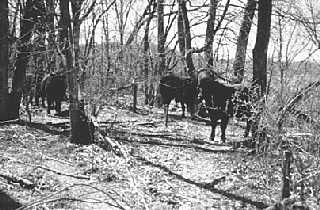Keep in mind this article is not intended to encourage cattle in the woods. It's quite the opposite. It does however provide you with some interesting information about what cattle come across in the woods, how much forage potential exists in an upland white oak stand and some alternatives and benefits of removing cattle from the woods.
In the forestry profession, we promote excluding cattle from woodlands. This benefits trees in a number of ways. However, landowners cite several reasons why they graze cattle in woodlands, such as: convenience, not having the time or money to build fences and maintain them; necessity; the water sources are in the woods; or it allows them to use property they feel is otherwise left idle.

On the other hand, landowners who choose to exclude cattle will site reasons such as: it is more profitable to maintain cattle on highly productive pasture than allowing them free range on low forage production in the woods; they are focused on timber management to gain periodic income; and there are toxic plants that cattle will eat if allowed in the woods.
Keep the above mentioned information in mind while you read the following.
I looked at some upland woods to determine forage potential and value as woodlands. Tree diameters ranged from 12 inches up to 20 inches, mainly white oak. The woods were thinned about 4 years ago to open the canopy and allow more sunlight, growing space, and groundcover development for wildlife. Prior to that they were grazed by cattle.
Forage samples were taken towards the end of the growing season to determine the annual production. This amounted to about 790 pounds per acre of woodland forage. This pales by comparison to what can be produced on pasture land which may range from 7,500 to 9,500 pounds per acre depending on the intensity of management. This probably comes as no surprise since the top reasons for grazing cattle in the woods are convenience and necessity. However, while cattle are grazing in the woods they are not maximizing weight gain like they would on the pasture.
In addition to poor forage, many of the plants present were not very palatable. Sedges made up a large percentage of the volume along with blackberry leaves and canes, blackhaw and fragrant sumac. Detrimental plants such as poison ivy and black cherry were also present in the woods. I noticed white oak seedlings and acorns. With a bumper acorn crop this year, I wonder if acorn toxicity was a concern to anyone?
So what are the alternatives? The particular stand I looked at had a good sawtimber component. The total standing volume today has 3,116 bd. ft. per acre with an estimated value of $625 per acre. If it were allowed to grow another 5 to 6 years, the volume would approximate 3,400 bd. ft. per acre and increase in value another $55 per acre. A thinning of about 1,114 bd. ft. would yield an income of $225 per acre and still leave $455 per acre worth of timber standing.
A timber sale is not a once in a lifetime event. By waiting 10 years the volume would grow back to approximately 3,135 bd. ft. per acre - exceeding the original starting volume.
As a forester, I would clearly state that this is the best use for the land. The presence of cattle would degrade the value of trees due to compaction and damage to stems and root systems. Cattle also inhibit the growth of desirable regeneration. Find a white oak stand with a hickory understory, and you know it's been grazed. Cattle tend to eat the oaks and leave the hickory seedlings. Honeylocust is also a frequent problem of grazed woodlands since cattle eat the pods and transport the seeds to other areas.
Good timber stand management can be a profitable choice, but it means that cattle stay in the pasture and out of the woods!